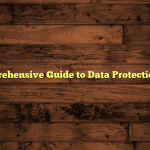Securing Artificial Intelligence: A Guide to Data Protection
Table of Contents:
- Why AI Data Security Matters
- Key Threats to AI Data
- Best Practices for Securing AI Data
- Advanced Tactics: Going Beyond Basics
- Collaboration & Compliance Are Important Too!
- Practical Steps Checklist For Organizations Implementing These Best Practices Today:
- FAQ
Securing Artificial Intelligence: A Guide to Data Protection
Is your AI data truly secure? As AI technology becomes more prevalent in everyday routines, from the applications on our phones to complex business operations, the data fueling those systems becomes a valuable yet vulnerable asset. Safeguarding this information is not simply a matter of confidentiality – it concerns the reliability, trustworthiness, as well as fairness of all AI-driven applications.
Why AI Data Security Matters
AI models gain knowledge from massive datasets. What happens if such information is compromised or stolen? The consequences can be severe, leading to skewed judgment, privacy infringements, even financial setbacks. The U.S. Cybersecurity & Infrastructure Security Agency (CISA) recently underscored the importance of protecting AI data so as to maintain the correctness of AI outcomes. If an organization expects its AI systems to function correctly, causing no harm, then its information must be well defended.
Key Threats to AI Data
Before we explore the solutions, it’s useful to identify the challenges:
- Data Poisoning – Attackers insert incorrect or deceptive information into training datasets, which results in the model learning inaccurate patterns.
- Adversarial Attacks – Hackers manipulate input data in a subtle manner, tricking the model into making flawed decisions.
- Unauthorized Access – Without suitable safeguards, sensitive information may be accessed by those who should not have the right to see it.
- Model Theft – Attackers may obtain copies of the fully trained models, utilizing them for malicious intent.
- Privacy Breaches – Private or confidential information used in training can be disclosed.
These are not just concepts – real occurrences result in tangible problems.
Best Practices for Securing AI Data
What are the ways to keep your AI protected? Organizations should think about the next practical steps:
1. Establish a Resilient Security Framework
Begin with defining guidelines on who can access specific data. It is advised to use identity management tools (like IAM) so that only authorized people can approach sensitive datasets. This entails establishing robust methods of authentication for logging in and regularly auditing user access rights.
2. Tightly Monitor Access
Not everybody needs all the data. Utilize role-based access controls (RBAC) so that people are only permitted access to the information necessary to fulfill their tasks, not any more than that. It is wise to frequently audit these permissions so old accounts do not create backdoors for attackers.
3. Encrypt All Sensitive Data
Encryption is a way of protecting data, both when it is stored (“at rest”) as well as when it is being transferred (“in transit”). Follow industry standards, such as AES-256 for storage encryption or TLS/SSL protocols, while sending information across networks.
4. Constantly Monitor
Establish constant monitoring tools that observe systems constantly. Watch for unusual actions that could be indicators of an active attack.
5. Audit Regularly
Regular auditing helps in finding weaknesses before hackers can utilize them – there is no need to wait until issues arise later on! Automated scanners along with ethical hacking methods, for example, penetration testing, will expose weaknesses early sufficient to prevent significant events!
6. Thoroughly Train Your Team
Human error remains one of the most significant challenges in any organization implementing advanced technology, including artificial intelligence projects specifically constructed to handle large amounts of Personally Identifiable Information (PII). Make certain that everyone is familiar with the fundamentals of cybersecurity procedures in addition to the specific threats related to machine learning environments. This involves continuous training classes, workshops, next to refresher courses. Quote:
“Misuse from misconfiguration often stem from human error – deliver role-based training on AI security, handling threat awareness across all project teams.”[4]
This quote shows that employee understanding is important – mistakes can occur, yet knowledge greatly minimizes this potential issue.
Advanced Tactics: Going Beyond Basics
Once standard safeguards are in place, there is still room for advancement, specifically involving sophisticated attacks on machine learning pipelines:
Countering Data Poisoning In order to protect training sets from corruption, one should enforce strict validation measures so as to detect anomalies inside incoming data streams while monitoring pipelines in order to identify questionable changes immediately! Utilizing a diversified sample group makes it harder to impact results – a single source is less able to skew the entire system dramatically when compromised…
Resisting Adversarial Attacks Train models so they recognize adversarial cases at the development stage. You do that by reproducing an attack scenario beforehand, then adding preprocessing layers in order to filter deceptive inputs prior to arriving at the final decision phase! This way, even brilliantly crafted malicious queries are not going to fool algorithms because of added security already set up through the design process instead of being retrofitted after the fact…
Safeguarding Intellectual Property Protect proprietary algorithms, including datasets, behind secure encrypted settings, implementing the highest restrictions that limit visibility outside the core group. That team is to safely maintain the algorithms’ lifecycle, deployment, along with updates!
Collaboration & Compliance Are Important Too!
Cooperation across departments to openly share knowledge helps one to discover new risks quicker than a siloed approach. Collaboration with universities, research facilities, regulatory bodies helps one to remain up-to-date with emerging threats. Influencing policies in order to assure compliance by having appropriate laws and regulations which govern utilizing Personally Identifiable Information (PII), health data, including financial transfers amongst other regions, as well as where the consequences are at their highest potential in terms of legal liability and reputational harm. Such events should be dealt with when they occur as opposed to after an extensive period of time!
Practical Steps Checklist For Organizations Implementing These Best Practices Today:
This is a quick overview with actions an organization should consider.
| Step | Description |
|---|---|
| Establish Clear Policies | Clearly define roles and responsibilities for accessing, modifying, storing, or transferring sensitive data. These rules should be well-documented and communicated to both internal and external stakeholders. |
| Implement Robust Authentication | Require multi-factor authentication (MFA) wherever possible to enhance account security. Enforce strong password policies and limit the number of failed login attempts to prevent brute-force attacks. |
| Enforce the Least Privilege Principle | Grant users only the permissions necessary to perform their job functions. This limits exposure in case of account compromise. |
| Encrypt All Sensitive Data (At Rest & In Transit) | Use strong cryptographic standards to protect data whether it’s stored locally, in the cloud, or being transmitted across networks. Encryption ensures confidentiality and integrity. |
| Monitor Continuously for Anomalies | Implement continuous monitoring and periodic audits to detect unusual behavior or potential breaches early. Early detection enables faster response and containment. |
| Educate the Team | Provide ongoing security training to employees about emerging threats like phishing, social engineering, and insider risks. Human error often presents a greater threat than technical vulnerabilities. |
FAQ
What makes AI data security different from general data security?
AI data security has special challenges stemming from the sensitive nature of the data used to train AI models. It includes data poisoning, adversarial attacks, along with concerns around intellectual property protection for models.
How often should we audit our AI data security practices?
Regular audits are important. They should be performed at least annually. This allows a business to identify possible weaknesses and be compliant with standards.
What are the most important encryption standards for AI data?
The most common standards are AES-256 for data storage plus TLS/SSL for data transmission.
Resources & References:
- https://www.cisa.gov/news-events/alerts/2025/05/22/new-best-practices-guide-securing-ai-data-released
- https://www.sentinelone.com/cybersecurity-101/data-and-ai/ai-data-security/
- https://www.newhorizons.com/resources/blog/ai-security-best-practices
- https://learn.microsoft.com/en-us/azure/cloud-adoption-framework/scenarios/ai/secure
- https://sysdig.com/learn-cloud-native/top-8-ai-security-best-practices/





